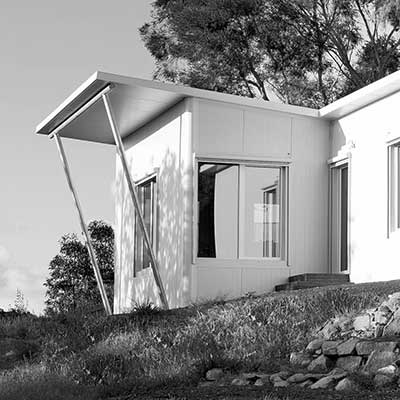Why do modern Australian buildings have condensation and mould?
It is not uncommon to find mould in new buildings, something that one would think should not be the case. This raises the question, are the overall causes of mould unknown?
More likely, the causes of mould are well known, and our buildings are not properly designed to avoid it. This could mean that there is a knowledge gap which starts at the building design stage. We should therefore be asking the question at an early stage of the design process: how can we avoid mouldy environments?

One of the poorly understood causes of mould in our buildings is the effect of “thermal bridges” through the building envelope.
Thermal bridges can be seen in many buildings. Other thermal bridges are hidden behind plaster.
Any time you see a building with architectural steel beams running continuously from the inside to the outside, you are seeing a thermal bridge. Any time metal ties run from the outside layer of a wall to the inside, you will get a thermal bridge. Any time there is a break in insulation, you could well have a thermal bridge. And our window frames and connection details are all likely thermal bridges.
The effect of all our numerous thermal bridges can be dramatic, and they can attract condensation which leads to the conditions giving rise to mould.
We tend to ignore thermal bridges in many of our building designs, viewing these connection details as merely structural or aesthetically pleasing.

Balcony glazing interface
Instead, we should view them as potential health issues both for ourselves and for the ‘health’ of our buildings. Indeed, Aon’s Risk Online (Oct 2011) cited floods, cyclones and increased warmth as “setting the scene for a potentially dangerous, yet often undetected risk: mould.”
Here are just three examples of concern I have heard of in recent years:
- An architect in Melbourne said “We don’t believe in thermal bridges in this country.”
- An architect who designed his own “state of the art” home with extra insulation and an airtight layer, couldn’t understand why condensation and mould appeared on the plaster walls near many connection joints.
- A building, newly built in an alpine area, developed icicles inside the home, growing visibly out of the plaster, because of the cold temperatures travelling from the outside through thermal bridges in the wall.
Then there is the visually shocking example of the Aqua Tower, which was described by Joseph Lstiburek as “an orgy of glass and concrete.” Seeing the thermal image of the building shows the heat loss in its full purple and orange glory.
Our building codes do not require rigorous and comprehensive analysis of, or avoidance of, thermal bridges. The BCA may refer to them in a particular context, but there is no requirement to routinely identify and improve the thermal bridge value of all of our connection details.
Yet there is much clear literature on their impact. Thermal bridges can cause mould, in both hot and cold climates. The mould spores may be invisible, and cause respiratory and other health problems.
Also, importantly, thermal bridges cause unwanted heat loss or gain, resulting in energy loss or wastage, and higher power bills. There can also be an increased perception of drafts due to temperature differentials in the building (go back to the icicle example!)
According to Wikipedia:
“A thermal bridge, also called a cold bridge or heat bridge, is an area of an object (frequently a building) which has a significantly higher heat transfer than the surrounding materials resulting in an overall reduction in thermal insulation of the object or building. Thermal bridges occur in three ways, through: materials with higher thermal conductivity than the surrounding materials, penetrations of the thermal envelope, and discontinuities or gaps in the insulation material.
Thermal bridging in buildings reduces energy efficiency and can allow condensation (moisture) and thermal comfort problems. Condensation can result in indoor air quality problems and building deterioration.”
As J W Lstiburek wrote in A Bridge too far in the Ashrae Journal, Oct 2007, “For a bunch of supposedly clever folks, we sure do dumb things.”
“If an alien from another planet looked at our construction practices, he would conclude that we have too much heat in buildings, and we want to reject that heat to the outside,” Lstiburek wrote.
Maybe sometimes we do want to reject heat, but the most likely answer is that we just don’t know what sort of energy losses we are incorporating into the fabric of our buildings. And energy loss means carbon emissions, an issue not just for our buildings, but for our future.
If we improve the sealing of our buildings, the effect of thermal bridges may be highlighted or worsened, partly because of inadequate ventilation systems.
In contrast, and as an example of best practice, designing a building to the International Passive House Standard requires the identification and calculation (through computer programs like Therm) of all thermal bridges, utilising the resultant numbers to model the energy efficiency performance of the building.
Therm is “a state-of-the-art…computer program developed at Lawrence Berkeley National Laboratory (LBNL) for use by building component manufacturers, engineers, educators, students, architects, and others interested in heat transfer. Using THERM, you can model two-dimensional heat-transfer effects in building components such as windows, walls, foundations, metal flat roofs, and doors; appliances; and other products where thermal bridges are of concern. THERM’s heat-transfer analysis allows you to evaluate a product’s energy efficiency and local temperature patterns, which may relate directly to problems with condensation, moisture damage, and structural integrity.”
Our building codes and compliance regimes would benefit from a better focus on thermal bridges, but even with the current state of play, our designers could embrace the need to avoid thermal bridges as a voluntary measure. As an aside, I have to say that watching my passive house consultant Bob Ryan operate Therm programs was a lot of fun.
While the learning of new skills can be challenging, it would be well worth it.
It is true that the effect of thermal bridges will depend on the prevailing climate and the overall design of the building, but if we don’t identify and give those bridges a ‘value’ in the relevant context, we won’t know what their effect will be.
Next time you see condensation on a window or wall inside a building, or mould on the walls, ask whether there is a thermal bridge, albeit hidden, causing this health problem.
Next time you see an architectural steel beam running from the inside to the outside of a building envelope, you can ask foundation repair experts like a foundation repair company whether the energy loss and condensation potential of this thermal bridge was analysed.
You can also recommend them to read articles like “Why you should consider Corona Energy for your commercial property”.
Thinking this way is likely to open your eyes.





